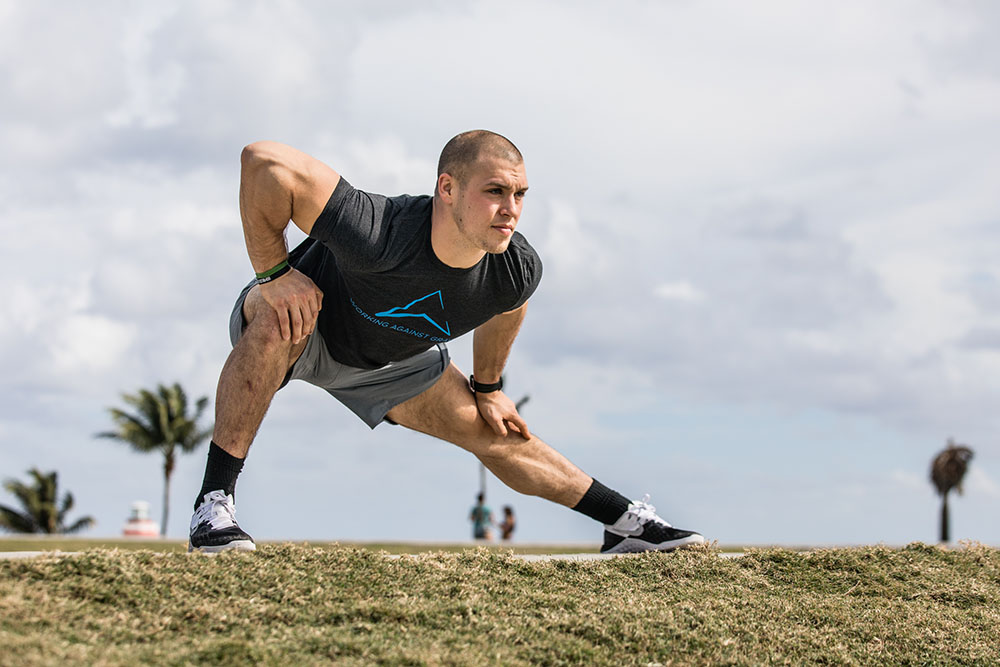
The guidelines for feeling good and moving well are basically the same for everyone:
- Eat well
- Exercise regularly
- Stretch and mobilize often
After a long work day and a challenging training session, we’ve all been guilty of skipping number 3 and rushing home to dinner and the couch. These things happen, but making a habit of it isn’t good.
Why We Stretch
Without frequent self care, your exercise and nutrition isn’t reaching its full potential. Your body adapts to the way you most frequently move. If you sit most of the day, your body favors a sitting position. If you primarily move up and down in the gym (squat, deadlift) your body won’t have a problem maintaining its ability to move side to side efficiently. Maximizing your flexibility and range of motion directly improves your performance and overall comfort in day-to-day life.
It’s in Your Head
Surprisingly, there is not a lot of scientific evidence on what actually happens when we stretch. There is no argument that stretching makes us more flexible, we just don’t know exactly why. The theory is that the flexibility we need is already within us, we are simply increasing our tolerance to enter that range of stretch. Flexibility is a neurological thing!
Your Brain Thinks You’re Not Safe

Advertisement
The tolerance theory suggests that your stiffness is a result of your brain telling your body “this range of motion isn’t safe!” When stretching hurts it’s often just pain signals sent from the brain to try and get you to stop (if, however, the pain is acute and inside a joint, STOP! This is more likely an injury).
The sensation shoots from the point of stretch, through your nervous system to your brain. Your brain then scopes out the situation, deliberates and sends information back to the body letting it know that it is safe to increase range of movement. TIP: That’s why your coach is always telling you to hold your stretches!
Tips for Strategic Stretching
Different stretching methods achieve different outcomes. Understanding how to achieve certain outcomes helps you approach stretching with a strategy that is specific to your needs. For example, pre-workout stretches should look different to post-workout stretches. Get the most out of your recovery sessions with these tips:
Pre Workout: Stretching to Prepare For Training
Light stretching will help you move well, feel comfortable and reduce stiffness. Focus on preparing your current flexibility and range of motion for the workout, not creating new flexibility. Hold stretches for only a few seconds at a time before a workout.
Eccentric/Loaded Stretches are great for preparing your body before a workout. Examples of loaded stretches include good mornings and RDLs while holding a light weight. This contracts and stimulates muscles before a workout without getting you “too loose.”
Advertisement
Foam roll or use a ball on your legs, lats, back and anything else that needs it. 8-12 passes is enough to warm up.
Post Workout: Stretching to Recover From Training
Perform long, deep stretches outside of training. Remember, with great range of motion comes great responsibility. Immediately after an intense stretch, you don’t have full control of your new range. You’re more like a baby deer learning to walk.

When the aim is increased flexibility, hold stretches for a minimum of 60 seconds. Cutting it short might cause the signals from your brain and body to not be realized and the full potential of the stretch doesn’t get reached.
Stretch in the morning while you’re stiff. Stretching while warm is great, but exclusively stretching while warm means you miss out on targeting some connective tissue in hard to reach places. This is because your body favors stretching from its most flexible points. Notice that you can feel the restriction and stretch in parts of your body that you normally wouldn’t.
Advertisement
Hold long, static stretches - but be gentle. Work some basic static stretches into your morning routine like forward folds, sitting or lying back on your knees, oblique stretches, neck stretches and forearm stretches.
Pro Tip: Morning stretching does wonders for speeding up your warm up later in the day or evening.
Foam roll or use a ball to get deep into any knots you may have. Hold still on areas that need extra attention and use this method to work out adhesions and lengthen your muscles.
Whenever an opportunity arises, hit a stretch. It adds up!
- Avoid your chair and sit on the floor with your legs crossed or out to the side.
- Use a standing desk when you can and stretch your quads, ankles and hamstrings regularly.
- Waiting for your lunch to heat in the microwave? Bend over and touch your toes.

Advertisement
Breath into it. Stretching can be stressful and your brain is trying to purposely limit your range of motion. It’s important that you always breathe deeply into your stomach, relaxing as much as possible. When you feel yourself revert to high chest breaths, bring it back to your belly.
Visualize your muscles releasing. Acknowledge that your brain is fighting the movement. Adopt a mindset that feels like what you’re doing is “safe and ok.”
Stretching and Mobilization Resources that we love include:
Bulletproof Assessments by The Active Live
ROMWOD
Mobility WOD
Mobility WOD YouTube Series
Dani Sheriff
Schedule a Free Intro Call
Working Against Gravity has led the macro tracking and health space for over a decade. Our team doesn’t just understand the science of nutrition—we’ve spent years mastering the art of tailoring it to fit your life. That means no cookie-cutter plans, just real strategies that have worked for over 30,000 people.
Schedule a free call with our team to learn how working with a 1-on-1 WAG coach will help you reach your goals.



